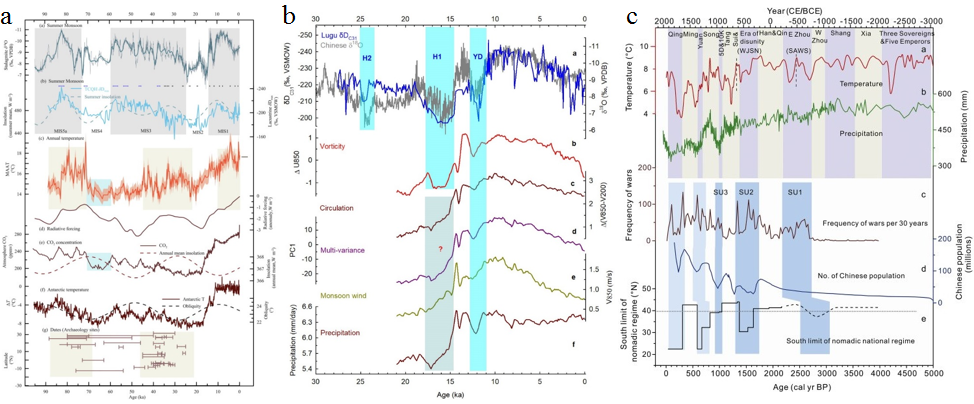新闻动态
NEWS

Datasets related to paleoclimate research in China Published at the National Tibetan Plateau/Third Pole Environment Data Center
Recently, researchers from Prof. ZHAO Cheng's group at Nanjing University published three scientific articles on paleoclimate reconstruction in China in the international journals such as Science Bulletin (IF=9.51), Geophysical Research Letters (IF=4.50), and Quaternary Science Reviews (IF=3.80). The papers are related to the "Quantitative temperature dataset for the past 90,000 years in southwest China", "Hydrogen isotope dataset of leaf wax from Lugu Lake, Southwest China since the last glacial maximum", and "Quantitative temperature and monsoon precipitation dataset for the past 5000 years in northern China", have been published and shared online at the National Tibetan Plateau/Third Pole Environment Data Center (https://data.tpdc.ac.cn/en/).
Prof. ZHAO Cheng led his group of researchers to reconstruct the paleoclimate using paleoclimate records from lake sediments in the study areas of Lake Tengchongqinghai in southwest China, Lugu Lake in southwest China, and Beilianchi Lake of Liupan Mountain in the Loess Plateau region of northern China, respectively. Among them, the analysis of Branched glycerol dialkyl glycerol tetraethers (brGDGTs) and wax hydrogen isotope (δDwax) records of Lake Tengchongqinghai has demonstrated for the first time the history of high-resolution annual mean temperature change on land at low latitudes since the last ice age (past 88,000 years), providing a new framework for climate change on land at low latitudes; using the δDwax record preserved in the Lugu Lake, the study has reconstructed continuous precipitation isotope data in the Indian monsoon region over the past 28,000 years, providing important evidence for revealing the hydroclimatic change pattern in this region; By analyzing brGDGTs in sediment cores from the Beilianchi Lake, we quantitatively reconstructed the warm season (April to October) temperature change data at high resolution (~30 years) over the past 5000 years in northern China, providing a quantitative climatic context for the historical and cultural evolution of China over the past 5000 years.
The research was supported by the National Natural Science Foundation of China (grant no. 41877293), the Strategic Priority Research Program of the Chinese Academy of Sciences (grant no. XDB40010200) and the China National Key R&D Program (grant no. 2019M660046).

Figure 1. (a) Comparison of annual mean temperature in South Asia with other reconstructed records; (b) reconstructed hydrogen isotope sequences of chlorine in the Lugu Lake with oxygen isotope sequences of other stalagmites and associated monsoon indices; (c) comparison of climate change with cultural evolution and social change over the past 5000 years.
Links to datasets and information on related articles are as follows, respectively.
1. Quantitative temperature data set for the past 90000 years in Southwest China
Data available at:
https://data.tpdc.ac.cn/en/data/56c0cb84-7f6e-431b-8ec9-a2b02dbe9d5d/
Full-text available at:
https://doi.org/10.1016/j.scib.2020.11.016
2. Hydrogen isotope data set of leaf wax from Lugu Lake, Southwest China since the last glacial maximu
Data available at:
https://data.tpdc.ac.cn/en/data/0c60e5b8-a1a5-4378-9acd-82e0610c932a/
Full-text available at:
https://doi.org/10.1029/2021GL092460
3. Quantitative temperature and monsoon precipitation data sets for the past 5000 years in northern China
Data available at:
https://data.tpdc.ac.cn/en/data/8aa08787-4e68-4095-8412-e5d57aadad8a/
Full-text available at:
https://doi.org/10.1016/j.quascirev.2021.106819



 京公网安备11010502040845号
京公网安备11010502040845号